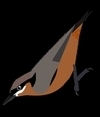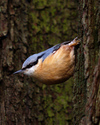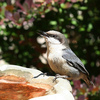Genus Sitta
Azure Nuthatch - Its natural habitats are subtropical or tropical moist lowland forests and subtropical or tropical moist montanes.
Canada Nuthatch - Adults have blue-grey upperparts with reddish underparts; they have a white face with a black stripe through the eyes, a white throat, a straight grey bill and a black crown. This bird is smaller than the White-breasted Nuthatch.
Tree Mouse - Like other nuthatches, the White-breasted Nuthatch forages for insects on trunks and branches, and is able to move head-first down trees. Seeds form a substantial part of its winter diet, as do acorns and hickory nuts that were stored by the bird in the fall. The nest is in a hole in a tree, and the breeding pair may smear insects around the entrance as a deterrent to squirrels. Adults and young may be killed by hawks, owls and snakes, and forest clearance may lead to local habitat loss, but this is a common species with no major conservation concerns over most of its range.
Kashmir Nuthatch - Its natural habitats are boreal forests and temperate forests.
Chestnut-bellied Nuthatch - Its natural habitats are subtropical or tropical dry forests, subtropical or tropical moist lowland forests, and subtropical or tropical moist montanes.
Nuthatch - This bird is the most common and most widespread nuthatch, and is often referred to just as the Nuthatch.
Beautiful Nuthatch - This is a large nuthatch, black-backed with white streaking. The upper back, rump and shoulders are bright blue. The underparts are dull orange, although the face is somewhat paler. In flight, a white patch contrasts with the otherwise dark underwing. Sexes are similar, as are young birds.
Velvet-fronted Nuthatch - It is a resident breeder of all types of woods, although open evergreen forest is the optimal habitat.
White-tailed Nuthatch - It may be identified by the buff underside, smaller beak than in Sitta cashmirensis. The white on the upper tail coverts is difficult to see in the field. It has a small bill and rufous-organge underparts with unmarked bright rufous undertail-coverts.
Kr - It occurs in Turkey, Georgia, Russia and on the Greek island of Lesvos.
Algerian Nuthatch - The Algerian Nuthatch is a resident bird of four areas of mountain forest in northeast Algeria. Its range is limited by the availability of woodland, and it occurs only above 1000m, with the population density increasing with altitude.
White-cheeked Nuthatch - Its natural habitats are boreal forests and temperate forests.
Giant Nuthatch - Its natural habitat is subtropical or tropical dry forests. It is threatened by habitat loss.
Chestnut-vented Nuthatch - Its natural habitats are temperate forests, subtropical or tropical moist lowland forests, and subtropical or tropical moist montanes.
Rock Nuthatch - The Western Rock Nuthatch is a bird associated with habitats with bare rocks, especially in mountainous areas. Those at the highest altitudes may move lower down in winter.
Sulphur-billed Nuthatch - Its natural habitats are subtropical or tropical moist lowland forests and subtropical or tropical moist montanes.
Gray-headed nuthatch - The Brown-headed Nuthatch, Sitta pusilla, is a small songbird found in pine forests throughout the Southeastern United States. An endangered population occurs in the pineyards of Grand Bahama; some authorities consider it to represent a separate species, S. insularis. The bird, like other nuthatches, possesses a sharp black nail-like beak, which it uses to pound open seeds. It is a frequent visitor to feeding stations and is highly fond of sunflower seeds and suet cakes.
Black-eared nuthatch - Pygmy Nuthatches nest in cavities in dead stubs of conifers, lining the bottom of the cavity with pine-cone scales, plant down, and other soft plant and animal materials. They may fill cracks or crevices around the entrance with fur; the function of this behavior is unknown. The female lays 4–9 eggs, which are white with fine reddish-brown spotting. She does most of the incubation, which lasts about 16 days. The young leave the nest about 22 days after hatching.
Yellow-billed Nuthatch - Its natural habitats are subtropical or tropical moist lowland forests and subtropical or tropical moist montanes. It is threatened by habitat loss.
White-browed Nuthatch - The endangered White-browed Nuthatch is known only from the Mount Victoria area of Burma, where forest up to 2,000 m has been almost totally cleared and habitat between 2,000-2,500 m has been heavily degraded. The population of a few thousand birds is decreasing, and no conservation measures are in place..
Chinese Nuthatch - Its natural habitat is temperate forests.
Corsican Nuthatch - The Corsican Nuthatch is a resident bird of the mountain forests of Corsica, and is closely associated with Corsican Pine preferably with some very old trees aged 300 years or more for nesting.
Yunnan Nuthatch - Its natural habitat is subtropical or tropical dry forests. It is becoming rare due to habitat loss.










